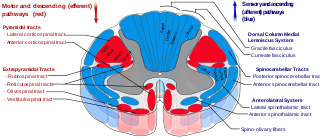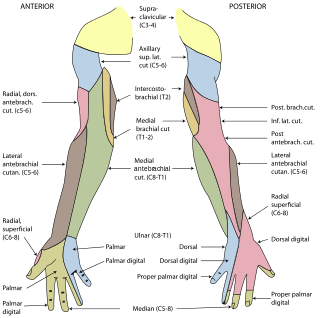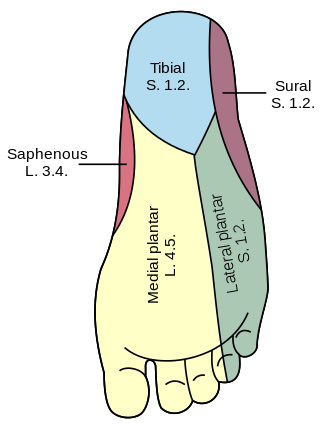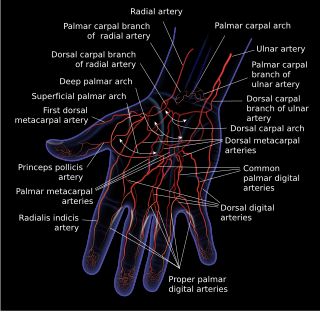
A dorsal fin is a fin located on the back of most marine and freshwater vertebrates within various taxa of the animal kingdom. Many species of animals possessing dorsal fins are not particularly closely related to each other, though through convergent evolution they have independently evolved external superficial fish-like body plans adapted to their marine environments, including most numerously fish, but also mammals such as cetaceans, and even extinct ancient marine reptiles such as various known species of ichthyosaurs. Most species have only one dorsal fin, but some have two or three.

In human anatomy, the metacarpal bones or metacarpus, also known as the "palm bones", are the appendicular bones that form the intermediate part of the hand between the phalanges (fingers) and the carpal bones, which articulate with the forearm. The metacarpal bones are homologous to the metatarsal bones in the foot.

The spinocerebellar tracts are nerve tracts originating in the spinal cord and terminating in the same side (ipsilateral) of the cerebellum. The two main tracts are the dorsal spinocerebellar tract, and the ventral spinocerebellar tract. Both of these tracts are located in the peripheral region of the lateral funiculi. Other tracts are the rostral spinocerebellar tract, and the cuneocerebellar tract.

The superficial fibular nerve is a mixed nerve that provides motor innervation to the fibularis longus and fibularis brevis muscles, and sensory innervation to skin over the antero-lateral aspect of the leg along with the greater part of the dorsum of the foot.

The superficial branch of the radial nerve passes along the front of the radial side of the forearm to the commencement of its lower third. It is a sensory nerve.

Most of the dorsal metacarpal arteries arise from the dorsal carpal arch and run downward on the second, third, and fourth dorsal interossei of the hand and bifurcate into the dorsal digital arteries. Near their origin, they anastomose with the deep palmar arch by perforating arteries. They also anastomose with common palmar digital arteries, also via perforating arteries.

In the palm of the hand the median nerve is covered by the skin and the palmar aponeurosis, and rests on the tendons of the flexor muscles. Immediately after emerging from under the transverse carpal ligament the median nerve becomes enlarged and flattened and splits into a smaller, lateral, and a larger, medial portion.

An extensor expansion is the special connective attachments by which the extensor tendons insert into the phalanges.

The proper palmar digital arteries travel along the sides of the phalanges, each artery lying just below its corresponding digital nerve.

The dorsal venous network of the hand is a venous network on the dorsum (backside) of hand. It is formed by the dorsal metacarpal veins, a dorsal digital vein from the radial side of the index finger and one from the ulnar side of the little finger, and both dorsal digital veins of the thumb. The venous network gives rise to the cephalic vein and the basilic vein; an accessory cephalic vein may arise from it as well.

The intermediate dorsal cutaneous nerve is the smaller and more lateral one of the two terminal branches of the superficial fibular nerve. It passes over the third intermetatarsal space before itself bifurcating into two terminal branches: the lateral dorsal digital nerve of the third toe, and the medial dorsal digital nerve of the fourth toe.

The medial dorsal cutaneous nerve is the more medial one of the two terminal branches of the superficial fibular nerve. Through its branches, it provides innervation to parts of the dorsal aspects of the first, second, and third toes.

Cutaneous innervation of the upper limbs is the nerve supply to areas of the skin of the upper limbs which are supplied by specific cutaneous nerves.
The arcuate artery of the foot gives off the second, third, and fourth dorsal metatarsal arteries, which run forward upon the corresponding Interossei dorsales; in the clefts between the toes, each divides into two dorsal digital branches for the adjoining toes.

The salivatory nuclei are two general visceral efferent nuclei located in the caudal pons, dorsal and lateral to the facial nucleus. Their neurons give rise to preganglionic parasympathetic nerve fibers in the control of salivation. The superior salivatory nucleus supplies fibers to the intermediate nerve (part of the facial nerve. The inferior salivatory nucleus supplies fibers to the glossopharyngeal nerve. The nuclei may also be involved in parasympathetic control of head vasculature.

The lateral dorsal cutaneous nerve is the continuation/terminal sensory branch of the sural nerve, and is ultimately derived from the 1st sacral nerve (S1). It passes distally along the lateral part of the dorsum of foot. It gives rise to the lateral dorsal digital nerve of the 5th toe, and sometimes also the medial dorsal digital nerve of the 5th toe as well as the lateral dorsal digital nerve of the 4th toe.

Dorsal digital nerves of foot are branches of the intermediate dorsal cutaneous nerve, medial dorsal cutaneous nerve, sural nerve and deep fibular nerve.

Dorsal digital nerves of ulnar nerve are branches on the dorsum of the hand. The dorsal branch of the ulnar nerve divides into two dorsal digital branches; one supplies the ulnar side of the little finger; the other, the adjacent sides of the little and ring fingers. It also sends a twig to join that given by the superficial branch of the radial nerve for the adjoining sides of the middle and ring fingers, and assists in supplying them.
The dorsal digital arteries of foot are small arteries which supply the toes.

Dorsal digital arteries arise from the bifurcation of dorsal metacarpal arteries. They travel along the sides and dorsal aspects of the phalanges of the middle finger, ring finger, and little finger. They communicate with the proper palmar digital arteries.














